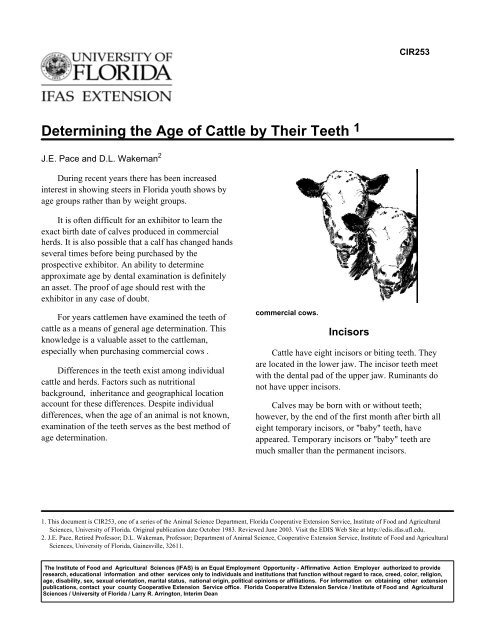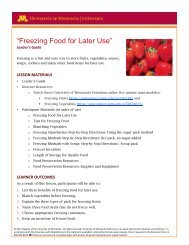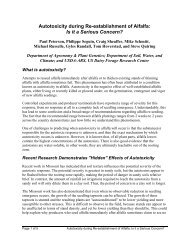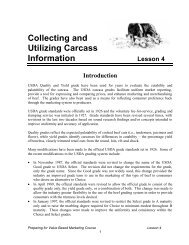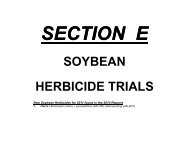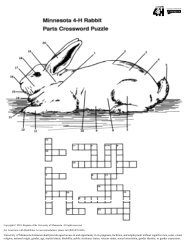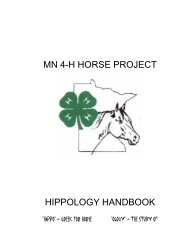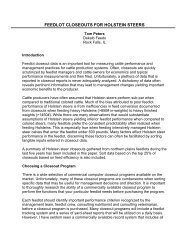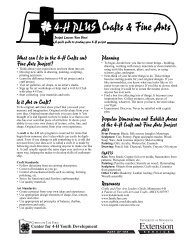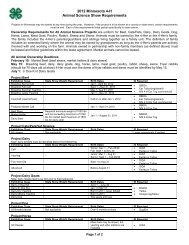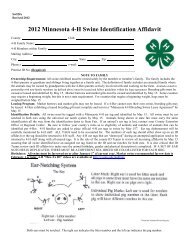Determining the Age of Cattle by Their Teeth 1 - University of ...
Determining the Age of Cattle by Their Teeth 1 - University of ...
Determining the Age of Cattle by Their Teeth 1 - University of ...
You also want an ePaper? Increase the reach of your titles
YUMPU automatically turns print PDFs into web optimized ePapers that Google loves.
CIR253<br />
<strong>Determining</strong> <strong>the</strong> <strong>Age</strong> <strong>of</strong> <strong>Cattle</strong> <strong>by</strong> <strong>Their</strong> <strong>Teeth</strong> 1<br />
J.E. Pace and D.L. Wakeman 2<br />
During recent years <strong>the</strong>re has been increased<br />
interest in showing steers in Florida youth shows <strong>by</strong><br />
age groups ra<strong>the</strong>r than <strong>by</strong> weight groups.<br />
It is <strong>of</strong>ten difficult for an exhibitor to learn <strong>the</strong><br />
exact birth date <strong>of</strong> calves produced in commercial<br />
herds. It is also possible that a calf has changed hands<br />
several times before being purchased <strong>by</strong> <strong>the</strong><br />
prospective exhibitor. An ability to determine<br />
approximate age <strong>by</strong> dental examination is definitely<br />
an asset. The pro<strong>of</strong> <strong>of</strong> age should rest with <strong>the</strong><br />
exhibitor in any case <strong>of</strong> doubt.<br />
For years cattlemen have examined <strong>the</strong> teeth <strong>of</strong><br />
cattle as a means <strong>of</strong> general age determination. This<br />
knowledge is a valuable asset to <strong>the</strong> cattleman,<br />
especially when purchasing commercial cows .<br />
Differences in <strong>the</strong> teeth exist among individual<br />
cattle and herds. Factors such as nutritional<br />
background, inheritance and geographical location<br />
account for <strong>the</strong>se differences. Despite individual<br />
differences, when <strong>the</strong> age <strong>of</strong> an animal is not known,<br />
examination <strong>of</strong> <strong>the</strong> teeth serves as <strong>the</strong> best method <strong>of</strong><br />
age determination.<br />
commercial cows.<br />
Incisors<br />
<strong>Cattle</strong> have eight incisors or biting teeth. They<br />
are located in <strong>the</strong> lower jaw. The incisor teeth meet<br />
with <strong>the</strong> dental pad <strong>of</strong> <strong>the</strong> upper jaw. Ruminants do<br />
not have upper incisors.<br />
Calves may be born with or without teeth;<br />
however, <strong>by</strong> <strong>the</strong> end <strong>of</strong> <strong>the</strong> first month after birth all<br />
eight temporary incisors, or "ba<strong>by</strong>" teeth, have<br />
appeared. Temporary incisors or "ba<strong>by</strong>" teeth are<br />
much smaller than <strong>the</strong> permanent incisors.<br />
1. This document is CIR253, one <strong>of</strong> a series <strong>of</strong> <strong>the</strong> Animal Science Department, Florida Cooperative Extension Service, Institute <strong>of</strong> Food and Agricultural<br />
Sciences, <strong>University</strong> <strong>of</strong> Florida. Original publication date October 1983. Reviewed June 2003. Visit <strong>the</strong> EDIS Web Site at http://edis.ifas.ufl.edu.<br />
2. J.E. Pace, Retired Pr<strong>of</strong>essor; D.L. Wakeman, Pr<strong>of</strong>essor; Department <strong>of</strong> Animal Science, Cooperative Extension Service, Institute <strong>of</strong> Food and Agricultural<br />
Sciences, <strong>University</strong> <strong>of</strong> Florida, Gainesville, 32611.<br />
The Institute <strong>of</strong> Food and Agricultural Sciences (IFAS) is an Equal Employment Opportunity - Affirmative Action Employer authorized to provide<br />
research, educational information and o<strong>the</strong>r services only to individuals and institutions that function without regard to race, creed, color, religion,<br />
age, disability, sex, sexual orientation, marital status, national origin, political opinions or affiliations. For information on obtaining o<strong>the</strong>r extension<br />
publications, contact your county Cooperative Extension Service <strong>of</strong>fice. Florida Cooperative Extension Service / Institute <strong>of</strong> Food and Agricultural<br />
Sciences / <strong>University</strong> <strong>of</strong> Florida / Larry R. Arrington, Interim Dean
<strong>Determining</strong> <strong>the</strong> <strong>Age</strong> <strong>of</strong> <strong>Cattle</strong> <strong>by</strong> <strong>Their</strong> <strong>Teeth</strong> 2<br />
The second pair <strong>of</strong> permanent incisors are in full<br />
wear at a relatively early three years <strong>of</strong> age. The third<br />
permanent pair <strong>of</strong> incisors erupt and are in full wear<br />
six or seven months later. The fourth pair (corners)<br />
erupt as <strong>the</strong> animal approaches four years, and all <strong>of</strong><br />
<strong>the</strong> teeth are in wear at 4 1/2 years <strong>of</strong> age.<br />
<strong>Age</strong> determinations past 4 1/2 years are less<br />
accurate and are determined <strong>by</strong> <strong>the</strong> wear on <strong>the</strong> apex<br />
surface <strong>of</strong> <strong>the</strong> incisor teeth. The center pair show wear<br />
at five, second pair at six, third pair at seven and <strong>the</strong><br />
corners at eight years <strong>of</strong> age. Evidence <strong>of</strong> wear<br />
becomes more distinct and <strong>the</strong> teeth obtain a<br />
triangular shape with continued wear. It is very<br />
difficult to determine age <strong>of</strong> cattle <strong>by</strong> examination <strong>of</strong><br />
teeth when <strong>the</strong>y are more than eight years old.<br />
Incisors Are Identified As Follows:<br />
• The middle pair are identified as <strong>the</strong> central<br />
incisors.<br />
• The pair next to <strong>the</strong> central incisors are<br />
identified as <strong>the</strong> middle incisors.<br />
• The pair next to <strong>the</strong> middle incisors are<br />
designated as <strong>the</strong> lateral incisors.<br />
• The pair next to <strong>the</strong> laterals are known as <strong>the</strong><br />
corner incisors.<br />
Eruption <strong>of</strong> <strong>the</strong> first permanent incisors (central)<br />
occurs when <strong>the</strong> animal is 19 to 20 months <strong>of</strong> age.<br />
This eruption is a gradual process. The temporary or<br />
"ba<strong>by</strong>" teeth become loosened and <strong>the</strong> gums are<br />
usually swollen. Quite frequently <strong>the</strong> permanent<br />
incisors begin appearing while <strong>the</strong> temporary teeth<br />
are still in <strong>the</strong>ir settings. They usually come in at an<br />
angle, <strong>the</strong> upper outside corner <strong>of</strong> <strong>the</strong> tooth being<br />
higher than <strong>the</strong> inside corner (see fig. 5 ).<br />
fig. 5.<br />
The following drawings and descriptions should<br />
assist cattlemen and youth exhibitors in determining<br />
<strong>the</strong> age <strong>of</strong> cattle. However, constant practice and<br />
examination <strong>of</strong> a large number <strong>of</strong> cattle <strong>of</strong> known age<br />
is necessary to establish pr<strong>of</strong>iciency.<br />
<strong>Age</strong>-14 months . All four pairs <strong>of</strong> teeth are<br />
temporary and firmly in place. The teeth are short,<br />
broad and usually have a bright ivory color. The teeth<br />
<strong>of</strong>ten touch on <strong>the</strong> inside corners at <strong>the</strong> top <strong>of</strong> <strong>the</strong><br />
teeth. Note <strong>the</strong> spreading that is usually present<br />
between <strong>the</strong> two center incisors. Steers with mouths<br />
similar to Figure 2 are exhibited in <strong>the</strong> younger class<br />
in Florida shows.<br />
Figure 1.<br />
<strong>Age</strong>-17 months . All teeth are temporary and set<br />
ra<strong>the</strong>r loosely in <strong>the</strong> jaw, especially <strong>the</strong> two center<br />
incisors. The teeth appear longer and more narrow<br />
than those in Figure 2. The teeth may or may not be<br />
touching at <strong>the</strong> upper corners. There is <strong>of</strong>ten a yellow<br />
or <strong>of</strong>f-white discoloration <strong>of</strong> <strong>the</strong> teeth near <strong>the</strong> base at<br />
<strong>the</strong> gum line. Steers with dental structures similar to<br />
Figure 3 are shown in <strong>the</strong> intermediate class.<br />
Figure 2.<br />
<strong>Age</strong>-19 to 20 months . Note <strong>the</strong> eruption <strong>of</strong> <strong>the</strong><br />
first permanent incisor tooth ( Figure 4 ). Both<br />
temporary incisors may or may not be present when<br />
this permanent tooth erupts. The permanent incisors<br />
will usually erupt at an angle and straighten into a<br />
definite pattern with continued growth. A steer with<br />
this tooth pattern is shown in <strong>the</strong> older class.<br />
<strong>Age</strong>-21 months . Both center incisors are<br />
evident, but <strong>the</strong>y may or may not be in a straight line<br />
with <strong>the</strong> inside corners touching ( Figure 5 ). These<br />
steers are shown in <strong>the</strong> older class.
<strong>Determining</strong> <strong>the</strong> <strong>Age</strong> <strong>of</strong> <strong>Cattle</strong> <strong>by</strong> <strong>Their</strong> <strong>Teeth</strong> 3<br />
Figure 3.<br />
Figure 7.<br />
<strong>Age</strong>-23 months . The permanent center incisors<br />
are in place and <strong>the</strong> inside corners are in line. These<br />
steers are also shown in <strong>the</strong> older class. The dental<br />
structure in Figure 6 is approaching <strong>the</strong> maximum<br />
limits for eligibility to show where dental<br />
classifications are used.<br />
Figure 5.<br />
<strong>Age</strong>-28 months . The second pair <strong>of</strong> permanent<br />
incisors have erupted but are not in wear. Steers with<br />
mouths similar to Figure 7 are too old to compete in<br />
Florida shows.<br />
Figure 6.<br />
Molars<br />
It is difficult to use <strong>the</strong> premolars for age<br />
determination, since <strong>the</strong>ir growth pattern is ra<strong>the</strong>r<br />
erratic ( Figure 8 ). The first pairs <strong>of</strong> permanent<br />
molars appear around five months <strong>of</strong> age. The center<br />
molars appear at 12 to 18 months, and are <strong>of</strong>ten used<br />
as a guide to split <strong>the</strong> younger and <strong>the</strong> intermediate<br />
classes when <strong>the</strong>re is some doubt about <strong>the</strong> pattern <strong>of</strong><br />
<strong>the</strong> incisors. The posterior, or third pair <strong>of</strong> permanent<br />
molars, appear between 24 and 30 months. The third<br />
pair <strong>of</strong> molars are <strong>of</strong>ten used to supplement <strong>the</strong><br />
incisor pattern when steers approach <strong>the</strong> maximum<br />
limits <strong>of</strong> <strong>the</strong> older class.
<strong>Determining</strong> <strong>the</strong> <strong>Age</strong> <strong>of</strong> <strong>Cattle</strong> <strong>by</strong> <strong>Their</strong> <strong>Teeth</strong> 4<br />
Table 1.<br />
Table 1.<br />
Premolars: 1, 2, 3<br />
Temporary-Birth to 1 mo.<br />
Permanent Molars<br />
4-5 to 6 mo.<br />
Permanent-2 to 3 1/2 yrs.<br />
5-1 to 1 1/2 yrs.<br />
6-2 to 2 1/2 yrs


